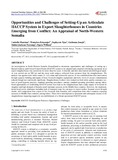| dc.contributor.author | Massimo, Castiello | |
| dc.contributor.author | Kinyanjui, Wamalwa | |
| dc.contributor.author | Njue, Sophycate | |
| dc.contributor.author | Gathuma, Joseph | |
| dc.date.accessioned | 2013-06-17T11:43:12Z | |
| dc.date.available | 2013-06-17T11:43:12Z | |
| dc.date.issued | 2013 | |
| dc.identifier.citation | Castiello Massimo, Wamalwa Kinyanjui, Sophycate Njue, Gathuma Joseph, Opportunities and Challenges of Setting-Up an Articulate HACCP System in Export Slaughterhouses in Countries Emerging from Conflict: An Appraisal of North-Western Somalia, Journal: Food and Nutrition Sciences ,2013 Volume: 04 Issue: 02 Pages: 126-130 | en |
| dc.identifier.issn | 2157944 | |
| dc.identifier.uri | http://www.doaj.org/doaj?func=abstract&id=1255299 | |
| dc.identifier.uri | http://erepository.uonbi.ac.ke:8080/xmlui/handle/123456789/34871 | |
| dc.description.abstract | An investigation in North-Western Somalia (Somaliland) to determine opportunities and challenges of setting up a Hazard Analysis and Critical Control Points (HACCP) system to be adopted and complied with during operations in an export slaughterhouse was carried out for more than two years. A baseline and after intervention microbiological analysis was carried out on 500 wet and dry meat swab samples collected from carcasses from the slaughterhouse. The analysis was against total viable counts, E. coli counts and Salmonella species. It was established that after intervention through capacity building and supply of basic livestock slaughter equipments and tools, levels of carcass contamination reduced though not statistically significant. Slaughterhouse workers were trained on food safety quality assurance systems of good hygiene practices, standard operating procedures, sanitary standard operating procedures among others. Good opportunities of establishing HACCP system were high as the slaughterhouse had a ready supply of livestock for slaughter and high demand of Somalia small ruminant carcasses in the Middle East countries. However, the implementation faced severe challenges including lack of transport plane for carcasses to export market, frequent severe drought shocks, stiff competition from export of live livestock from Somalia, stiff competition from other countries exporting carcasses to Middle East countries; among others. These led to interruptions to operations and subsequent closure of the slaughterhouse impacting negatively on establishment of a vibrant operational HACCP system. | |
| dc.language.iso | en | en |
| dc.publisher | University of Nairobi, | en |
| dc.title | Opportunities and Challenges of Setting-Up an Articulate HACCP System in Export Slaughterhouses in Countries Emerging from Conflict: An Appraisal of North-Western Somalia | en |
| dc.type | Article | en |

